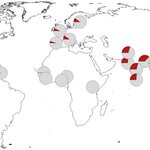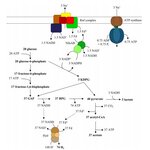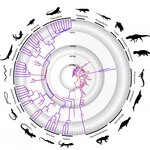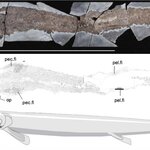Evolution

Charles Darwin and many others knew about the wing loss habit of island insects and debated famed botanist Joseph Hooker as to why. Darwin's position was simple that an insect on an island that flies is at more risk of being blown out to sea. Those left on land to produce the next generation are those most reluctant to fly, and eventually evolution follows behavior.
Hooker felt that was more Lamarckian than evolution, the same look elsewhere effect that plagues epigenetics today, and many other scientists side with Hooker, as recently as Roff in 1990 (The evolution of flightlessness in…

The overwhelming majority who have gotten or ever will get COVID-19, resulting from the third coronavirus pandemic, named SARS-CoV-2, of this century, won't know it. Most who are not asymptomatic will have it be the same as a cold.
Yet a few will have severe reactions and require hospitalization. Just like with flu or any cause of respiratory distress, age is the biggest risk factor, as are preexisting conditions that can aggravate numerous health issues, but research by the COVID-19 Host Genetics Initiative has shown that genetic variants in one region on chromosome 3 impose a larger…

Try to imagine a world where people though wild lettuce was a status symbol and superior to lettuce grown on a farm; a salad would cost $400.
That is the problem with salmon. Elite customers want to know a laborer sweated for it, they insist if it is farmed it must be inferior but unlike organic certified pineapples or non-GMO rock salt, the naturalist fetish has real world consequences when it comes to the sea. Salmon are getting smaller, because they are spending less time at sea before being caught.
A recent analysis looked at Oncorhynchus kisutch (coho), O. nerka (sockeye), O. tshawytscha…

Life developed when there was no oxygen on earth. It was an anoxic environment dominated by bacteria, who instead of oxidation and reduction, as our mitochondria do to produce energy, probably extracted various substances by means of fermentation.
But there has long been another possibility; a kind of “oxygen-free respiration” hinted at in studies on primordial microbes that are still found in anoxic habitats today. There have been found genes in microbes that perhaps encode for a primordial respiration enzyme.
Yet proving the existence of this respiratory enzyme and isolating…

In order to evolve you must first survive, and Darwin posited that this "survival of the fittest" was a driver in natural selection. To the casual reader in 1859, cooperation was hard to reconcile with that, but humans had become the apex predator by both cooperating and competing.
Cooperation is actually quite common. We have bacteria in our guts which can be helpful or harmful but are often helpful. Root bacteria fix nitrogen from the atmosphere, thus making it available to plants. In return, the plant supplies its root bacteria with nutritious sugars. Our own energy cells,…

Though we've learned a lot about evolution in the last 150 years, when it comes to the details, some fundamental questions remain unanswered. Such as when and how extremely diverse groups of animals such as reptiles first evolved. For seventy-five years, adaptive radiation, the relatively fast evolution of many species from a single common ancestor, has been considered a major cause of biological diversity.
This has even been for the origins of major body plans (structural and developmental characteristics that identify a group of animals) and new lineages. Yet examining these rapid rates of…

In high school biology you learned that in humans, a normal cell contains 23 pairs of chromosomes; 22 autosomes, which are the same in both males and females, while in the 23rd, the sex chromosomes, females have two copies of the X chromosome while males have one X and one Y.
Their differences don't stop there. Chromosome pairs are numbered according to size, pair 1 being largest and 23 the smallest. And the Y is tiny compared to the X. X contains thousands of genes critical for life while the Y provides the instructions for initiating male development and making sperm.
Exactly how they work…

(Inside Science) -- Imagine putting your hand in a pile of poop. It stinks and squishes. What do you do next?
Most likely, you'll scrub that hand with plenty of soap -- and you don't need public health officials or a germ theory of disease to tell you that's the right thing to do. But when you touch the handrail on an escalator, it's much harder to remember that you could be picking up coronavirus germs.
Humans have instincts that have evolved over millions of years to steer them away from infectious diseases. In some ways, these psychological adaptations -- collectively dubbed "the…

An ancient Elpistostege fish fossil has revealed how the human hand evolved from fish fins, the missing evolutionary link in the 'fish to tetrapod transition', as fish began to foray in habitats such as shallow water and land during the Late Devonian period millions of years ago.
This complete fish, around five feet in length, shows the complete arm (pectoral fin) skeleton for the first time in any elpistostegalian fish. The first instance of unequivocally discovered fingers locked in a fin with fin-rays in any known fish. The articulating digits in the fin are like the finger bones found in…

Merge is a controversial belief by some that human language faculty arose in humans through a single gene mutation, rather the evolving gradually.
This human burst of genetic exceptionalism is embraced by some linguists, such as Noam Chomsky, but the science community has doubts. The basis for Merge is that humans are genetically equipped with a unique cognitive capacity that specifically allows us to implement computations over hierarchically structured symbolic representations.
"Put it simple, Merge takes two linguistic units (say, words) and combines them into a set that can…